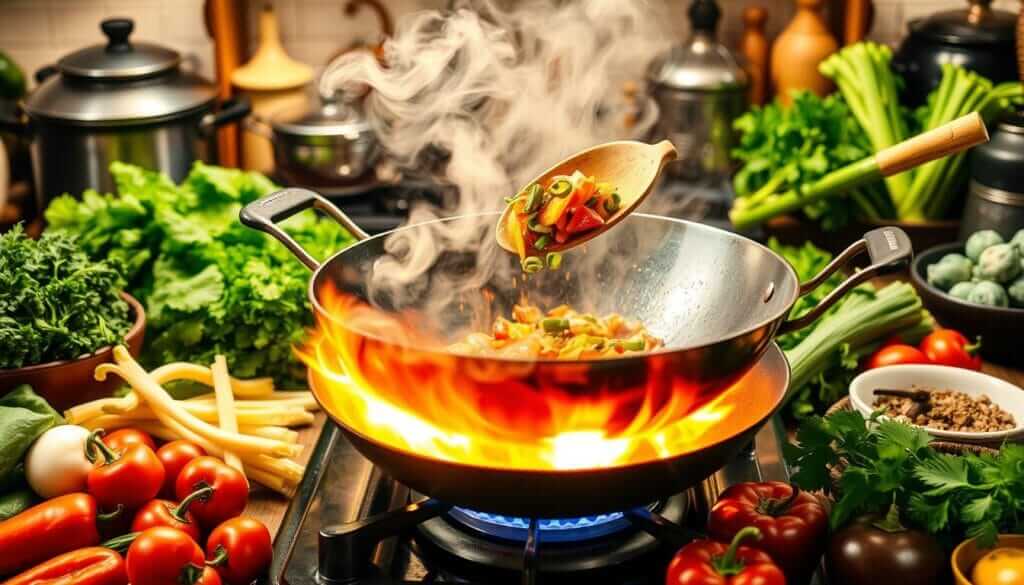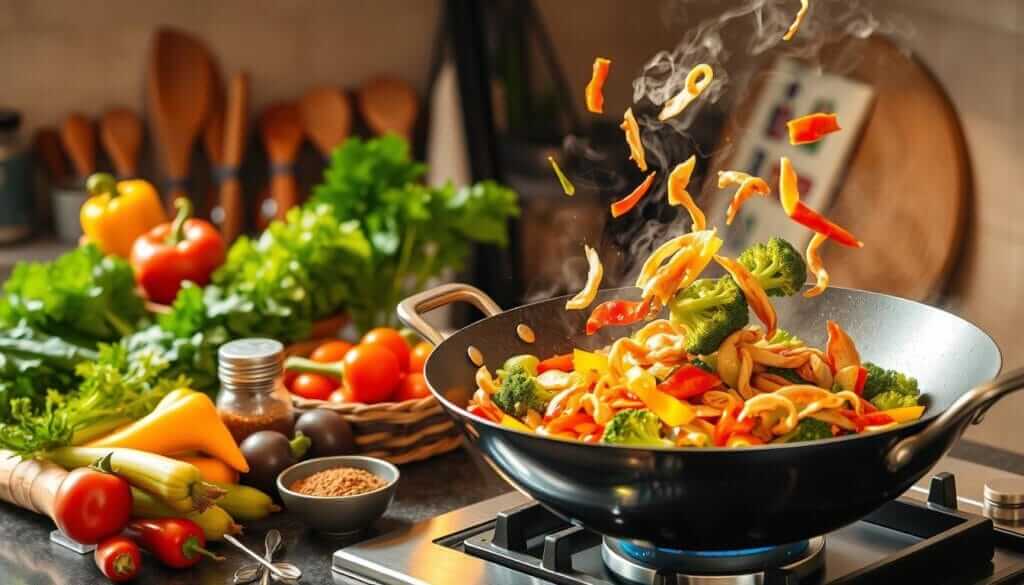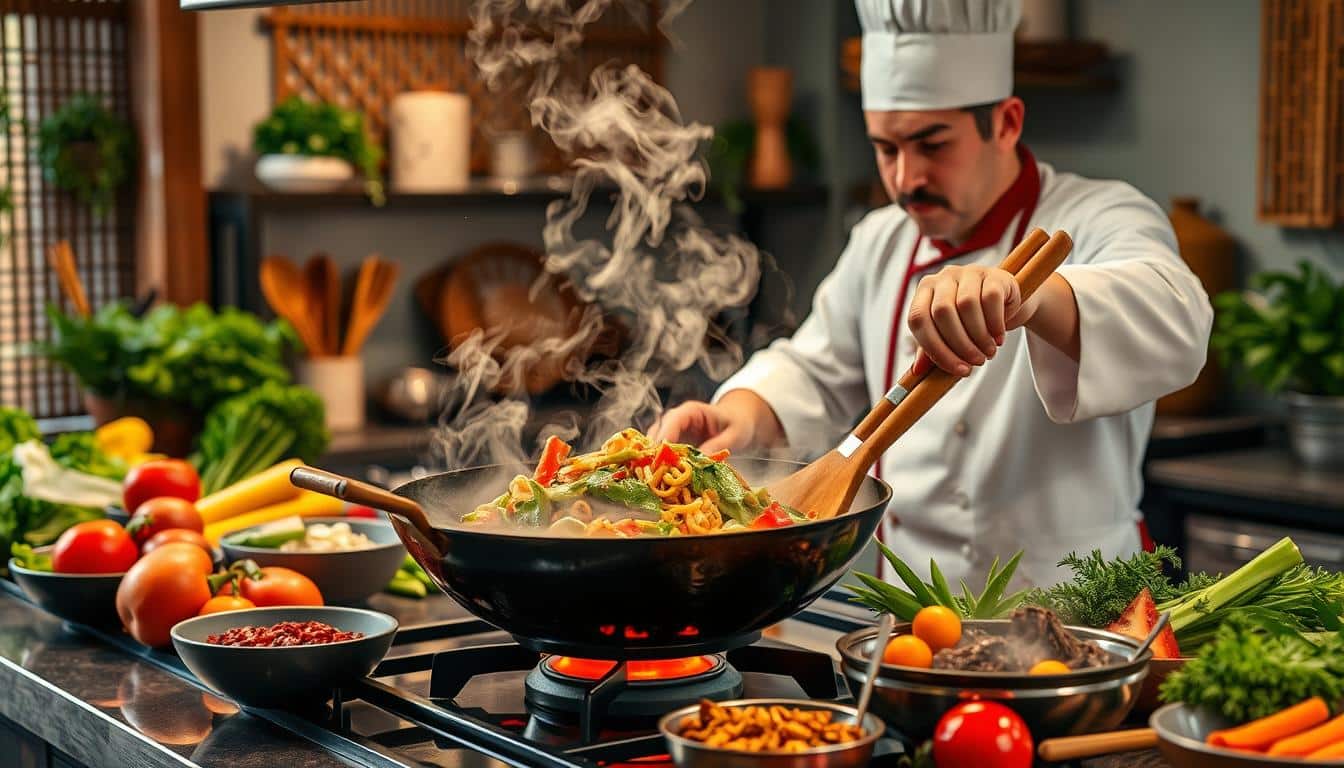The first time I watched my grandmother cook with her Asian wok, I was amazed. Steam danced around her hands, and the kitchen filled with amazing smells. Vegetables changed in seconds, turning into a feast for the senses.
Asian wok cooking is more than just cooking. It’s a vibrant art that adds speed, nutrition, and flavor to your meals. Whether you’re new to cooking or have experience, learning these techniques can change your meals forever.
In this guide, we’ll look at 15 tasty wok recipes that are easy and quick. You’ll find everything from stir-fried veggies to juicy protein dishes. These recipes will make your cooking at home a breeze.
What is Wok Cooking?
Exploring the art of wok cooking opens a world of flavors. A wok is more than a tool; it’s a key to making meals special. For beginners, understanding its design and cooking ways is crucial for making tasty Asian dishes.

The History of the Wok
The wok has a long history in China, over 2,000 years. Traditional Chinese kitchens made it to cook many things fast. Its shape helps cook food evenly and quickly.
“The wok is not just a pan, it’s a cultural cooking instrument that tells a story of culinary innovation.” – Chef Ming Chen
Different Types of Woks
For beginners, there are many woks to choose from:
- Carbon Steel: Most traditional and popular material
- Cast Iron: Extremely durable with excellent heat retention
- Stainless Steel: Smooth surface with great heat conduction
- Non-Stick: Modern option for easy cooking and cleaning
| Wok Type | Diameter | Key Characteristics |
|---|---|---|
| Carbon Steel | 14 inches | Lightweight, quick heat conduction |
| Cast Iron | 12-14 inches | Excellent heat retention, heavy |
| Stainless Steel | 14 inches | Durable, smooth cooking surface |
Why Cook with a Wok?
Using a wok has many benefits. Its shape lets you cook a lot with little oil. It cooks food fast and evenly, keeping nutrients and flavors strong. Whether you’re stir-frying or searing, a wok makes cooking versatile.
Essential Asian Wok Cooking Techniques
Learning how to cook with a wok can turn simple meals into amazing dishes. Wok cooking is more than just cooking. It’s about blending flavors and textures in a way that’s unique to Asian cuisine.

Wok cooking needs skill and knowing how to control heat. Professional chefs say success comes from three things: how you prepare, manage heat, and time.
Stir-Frying Basics
Stir-frying is at the core of wok cooking. It involves:
- Cutting ingredients into uniform sizes
- Preheating the wok until it begins to smoke
- Using high smoke point oils like peanut or canola
- Maintaining constant movement of ingredients
Sautéing and Steaming
Your wok is great for more than just stir-frying. Versatility is its greatest strength. Sautéing cooks ingredients slowly, while steaming keeps nutrients in and makes food tender.
“The wok is not a pan, it’s a culinary canvas” – Chef Martin Yan
Flambéing for Flavor
Flambéing brings excitement and flavor to dishes. It involves carefully setting alcohol on fire, which caramelizes food and adds unique tastes.
| Technique | Heat Level | Cooking Time |
|---|---|---|
| Stir-Frying | High | 2-5 minutes |
| Sautéing | Medium-High | 5-10 minutes |
| Steaming | Medium | 8-15 minutes |
Remember, practice makes perfect. Each technique needs patience and passion to master the art of wok cooking.
Must-Have Tools for Wok Cooking
Mastering the art of wok cooking is more than just skill. The right tools can make a big difference. They help you create delicious meals with ease. Knowing how to use an asian wok starts with the right equipment for your kitchen.
Choosing the Right Wok
When picking an asian wok, keep these points in mind:
- Material: Stainless steel and carbon steel are top choices
- Size: 14-inch woks offer optimal cooking space
- Bottom type: Flat-bottomed woks work best for home ranges
“The right wok is like a culinary partner in your kitchen” – Professional Chef
Essential Utensils
| Utensil | Price | Purpose |
|---|---|---|
| Helen’s Asian Kitchen Silicone Wok Spatula | $26.00 | Stir-frying and mixing ingredients |
| Zwilling Gourmet 7″ Chinese Chef’s Knife | $109.95 | Precise ingredient preparation |
| Helen’s Asian Kitchen 5″ Spider Strainer | $23.95 | Draining and removing foods |
Kitchen Setup Tips
Getting your kitchen ready for wok cooking is key. Ensure proper ventilation, have a stable heat source, and organize your ingredients. A well-prepared workspace makes cooking smoother and more fun.
Pro tip: Invest in quality tools that will last. Taking care of your wok and utensils will improve your cooking experience. It helps you make delicious meals every time.
Key Ingredients for Asian Wok Dishes
Making authentic Asian wok dishes begins with knowing the key ingredients. These ingredients add vibrant flavors and textures to your meals. The right mix of fresh produce, proteins, and seasonings can turn your meal into a masterpiece.
Fresh Vegetables: The Colorful Foundation
Asian wok dishes come alive with fresh, colorful vegetables. Your wok can quickly turn these healthy foods into tasty dishes.
- Bell peppers (red, green, yellow)
- Broccoli florets
- Carrots
- Bok choy
- Snow peas
- Mushrooms
Proteins: Diverse and Delicious
Authentic Asian wok dishes offer a wide range of proteins. This variety meets every dietary need.
- Chicken breast
- Beef tenderloin
- Shrimp
- Tofu
- Eggs
“The secret to amazing stir-fry is using fresh, high-quality ingredients and cooking them quickly.” – Chef Ming Tsai
Flavor Boosters: Sauces and Spices
Enhance your dishes with these essential flavor boosters:
- Soy sauce
- Sesame oil
- Ginger
- Garlic
- Chili paste
- Rice vinegar
Mastering these ingredients lets you make restaurant-quality Asian wok dishes at home. Remember, the magic is in the fresh ingredients and quick cooking technique!
Simple Asian Wok Recipes for Beginners
Starting your Asian wok cooking journey might seem scary, but it’s easy with the right recipes. The best recipes are simple and let you practice basic techniques. These dishes will help you get better at wok cooking quickly.
Classic Vegetable Stir-Fry
This stir-fry is great for beginners. It’s healthy and quick to make. It’s a good place to start because most beginner recipes are stir-fries.
- Prep time: 15 minutes
- Cooking time: 10 minutes
- Calories: 266 per 1 cup serving
- Key vegetables: Bell peppers, zucchini, bok choy
Teriyaki Chicken with Broccoli
This dish combines sweet and savory flavors. It teaches you about marinating. Pro tip: Most Asian wok recipes benefit from marinating, which makes them taste better.
- Marinating time: 30 minutes
- Cooking time: 15 minutes
- Calories: 398 per serving
- Protein options: Chicken, tofu (for vegetarian alternative)
Easy Fried Rice
Fried rice is a must-have for beginners. It’s great for using leftovers and learning wok techniques.
- Total preparation time: 25 minutes
- Calories: 476 per 1-1/2 cups serving
- Customizable with various proteins and vegetables
“Cooking is about passion, so approach these recipes with enthusiasm and don’t be afraid to experiment!” – Wok Cooking Expert
Remember, the more you practice, the better you’ll get at wok cooking. Start with these easy recipes and see your skills improve with each dish.
Popular Asian Wok Dishes to Try at Home
Exploring popular Asian wok stir fry recipes can change your cooking at home. Authentic Asian wok dishes add exciting flavors and quick meals to your kitchen. Let’s explore three amazing recipes to boost your cooking skills.
Pad Thai: A Thai Classic
Pad Thai is a mix of tangy and sweet flavors. It has 361 calories per serving, with 8g fat and 19g protein. You can also add chicken or tofu to make it your own.
- Quick preparation time (20-25 minutes)
- Balanced nutritional profile
- Adaptable to different protein preferences
Beef Chow Mein: Savory Noodle Delight
Beef Chow Mein mixes tender beef with crisp veggies in a tasty sauce. It’s a filling meal with about 357 calories, 15g fat, and 30g protein. This dish shows how versatile wok cooking can be.
| Ingredient | Quantity |
|---|---|
| Beef strips | 8 oz |
| Mixed vegetables | 2 cups |
| Noodles | 4 oz |
Korean BBQ Beef Bowls: Flavor Explosion
Korean BBQ Beef Bowls bring the bold flavors of Korean food. They’re packed with protein and veggies, making a complete meal in one bowl. Marinating the beef overnight makes it tender and flavorful.
*Pro tip: Try different marinades to find your favorite flavor!*
These Asian wok stir fry recipes show the wide range and simplicity of wok cooking. With little prep time and lots of flavor, you can make restaurant-quality meals at home.
Cooking Tips for Perfect Wok Dishes
Mastering the art of wok cooking takes skill and precision. Learning to use a wok well can make your cooking at home better. It can turn simple ingredients into meals that taste like they’re from a restaurant.
Professional chefs say that three things are key for great wok cooking. These are preparation, managing the heat, and timing. Each is important for making dishes that are both tasty and authentic.
Preparing Ingredients in Advance
Getting ready is crucial in wok cooking. Here are some important steps to follow before you start:
- Chop all vegetables the same size for even cooking
- Marinate proteins with soy, ginger, and garlic
- Keep all ingredients within arm’s reach
- Measure out sauces and seasonings before you start
“Mise en place is the secret to stress-free wok cooking” – Professional Chef
Heat Management Techniques
Knowing how to control the heat is key to using a wok. Stainless steel and carbon steel woks are great for quick, hot cooking. Here are some tips to keep in mind:
- Heat your wok until it’s very hot
- Use peanut oil because it can handle high heat
- Keep the heat high for the best stir-fry
- Move ingredients fast to avoid burning
Timing Your Cooking
Wok cooking is all about speed and accuracy. Different foods cook at different rates. Start with proteins, then add harder vegetables, and finish with quick-cooking greens like spring onions.
Pro tip: Practice makes perfect when learning asian wok cooking techniques!
Meal Prep with Asian Wok Recipes
Learning to prep meals can change your cooking game with the best Asian wok recipes. It’s easier for beginners with the right planning and storage tips. Meal prep saves time, cuts down stress, and keeps your meals tasty all week.
For great meal prep with wok cooking, you need smart strategies. These keep your food flavorful and nutritious. Your aim is to make dishes that stay delicious even after they’re stored.
Planning Your Weekly Menu
Here are some tips to make meal prep easier:
- Pick recipes that reheat well
- Choose ingredients that cook at the same time
- Prep veggies and proteins ahead of time
- Store food in airtight containers
Storing Cooked Dishes
| Dish Type | Refrigerator Storage | Freezer Storage |
|---|---|---|
| Stir-Fry Vegetables | 3-4 days | 1-2 months |
| Protein Dishes | 3-4 days | 2-3 months |
| Noodle Dishes | 2-3 days | 1 month |
Reheating Tips for Best Flavor
Keep your Asian wok dishes tasting fresh with these reheating tips:
- Reheat in a wok or skillet for quick, even cooking
- Add a bit of water or broth to avoid dryness
- Stir constantly to heat evenly
- Try to avoid microwaving to keep texture right
“The secret to great meal prep is not just cooking, but cooking smart.”
Health Benefits of Cooking with a Wok
Wok cooking is more than just a way to cook—it’s a healthy choice. Traditional Asian wok dishes are not only tasty but also packed with nutrients. They can change how you cook and eat.
Nutrient Retention through Stir-Frying
Asian wok cooking is great at keeping food’s nutrients. Stir-frying quickly helps veggies keep their vitamins and minerals. This method cooks food fast, so nutrients stay inside, unlike slow cooking that can lose them.
- Reduces cooking time to 3-5 minutes
- Maintains vegetable color and crispness
- Preserves up to 90% of original nutrient content
Using Less Oil for Healthier Meals
Carbon steel woks need little oil, making them good for those watching their fat intake. Their shape and heat spread evenly, allowing for tasty meals with less fat.
“Wok cooking transforms healthy ingredients into extraordinary meals with minimal oil.”
| Cooking Method | Oil Usage | Nutrient Retention |
|---|---|---|
| Deep Frying | High (3-4 tbsp) | Low |
| Wok Stir-Frying | Low (1 tbsp) | High |
The Role of Fresh Ingredients
Fresh ingredients are key to healthy wok cooking. Picking seasonal, local produce boosts nutrition and taste. The WHO says eating nutrient-rich foods can fight iron deficiency, affecting 30% of people worldwide.
- Choose seasonal vegetables
- Use lean proteins
- Incorporate diverse, colorful ingredients
Exploring Asian Cuisine Through Wok Cooking
Wok cooking is a journey into Asian culinary traditions. It lets you discover flavors, techniques, and cultural richness. It’s more than just cooking meals.
Regional Variations of Wok Dishes
Asia’s different regions have their own wok cooking styles. Each area adds its unique touch:
- Chinese provinces have their own stir-fry ways
- Thai cuisine is known for its bold, spicy dishes
- Japanese cooking is all about precise, delicate methods
- Vietnamese dishes use fresh herbs and quick cooking
Fusion Cooking with a Wok
Wok cooking is versatile, perfect for culinary experiments. Fusion cuisine mixes ingredients and flavors from various cultures.
“A wok is not just a cooking tool, it’s a bridge between culinary traditions.” – Chef Ming Tsai
Cultural Significance of Wok Meals
Wok cooking is more than cooking. It’s a cultural connection, bringing families together. It preserves culinary wisdom through generations.
Exploring these cooking styles shows the beauty of Asian cuisine. It’s a journey of flavors, one stir-fry at a time.
Final Thoughts on Asian Wok Cooking
Your journey into asian wok cooking is just starting. Every time you use your wok, you’ll learn something new. It’s not just a cooking tool but a way to explore new flavors and cultures.
Learning to cook with a wok takes time. Start with basic stir-frying and try different ingredients. Heat is key to flavor, as chefs like Erik Cheah from Wok Wok Southeast Asian Kitchen show.
Encouragement to Experiment
Don’t worry about making mistakes in your wok cooking. Every chef starts somewhere. Your skills will grow with each dish you make.
Try new protein combinations and sauces. Challenge yourself to make dishes that inspire you. Your kitchen is a place for creativity.
Resources for Further Exploration
Keep learning with cooking classes and online tutorials. Read cookbooks on asian wok techniques. Connect with Asian cooking communities or online forums for tips and recipes.
Join the Wok Cooking Community
Cooking is about sharing and making friends. Look for local cooking groups and food festivals. Join others who love asian wok cooking. Your journey is just starting, and exciting discoveries await.
FAQ
What type of wok is best for beginners?
Beginners should start with a carbon steel wok. It’s affordable, heats well, and is light. Choose a flat-bottomed wok for your home stovetop for better stability and heat.
How do I season a new wok?
First, wash the wok to remove any coating. Dry it well, then heat it over medium-high. Add a thin layer of peanut or vegetable oil.
Spread the oil evenly and heat until it smokes. Do this 2-3 times to create a non-stick layer.
What are the most essential tools for wok cooking?
You’ll need a wok spatula, a long-handled ladle, a strainer, and a lid. Long chopsticks are also useful for stirring.
Can I use a wok on an electric or induction stovetop?
Yes, but you need a flat-bottomed wok for electric or induction. Traditional woks work best with gas stoves. Look for a wide, flat base for electric or induction.
How do I prevent food from sticking to the wok?
Keep your wok seasoned and hot before adding oil. Use enough oil to coat the surface. Preheat the wok well, then add oil and ingredients.
Keep ingredients moving to prevent sticking.
What’s the difference between stir-frying and sautéing?
Stir-frying cooks small pieces quickly over high heat. Sautéing is done at medium heat with less movement. Stir-frying is quicker and uses less oil.
How can I make my wok dishes healthier?
Use less oil, choose lean proteins, and add lots of vegetables. Use low-sodium sauces and avoid deep-frying. Try steaming or light stir-frying.
How do I clean and maintain my wok?
Clean your wok with hot water and a soft sponge. Dry it well to prevent rust. Apply a light coat of oil after cleaning.
Never use steel wool or put it in the dishwasher.
What are some beginner-friendly wok recipes?
Start with vegetable stir-fry, fried rice, teriyaki chicken, and simple noodle dishes like Pad Thai. These recipes are easy and require minimal ingredients.
Can I use a wok for more than just stir-frying?
Absolutely! Woks are versatile. You can steam, deep-fry, boil, smoke, and even make soups and stews. Their shape and heat distribution make them great for many dishes.



